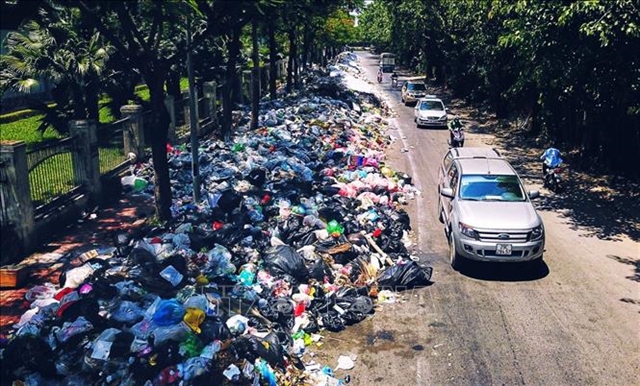SANITATION-Environment: HÀ NỘI – People ask for long-term solution over waste collection
Photo taken on July 16 shows waste along Trần Đức Dục Street in Nam Từ Liêm District. — VNA/VNS Photo Thành Đạt
.
.
.
HÀ NỘI — Big heaps of waste that have appeared beside roads in Hà Nội’s inner city districts for the last three days are expected to be cleared up by Friday, as people living around the Nam Sơn landfill agreed to stop blocking the way to the city’s biggest dump.
At a meeting with voters in Hoàn Kiếm District on Friday morning, chairman of the city’s People’s Committee Nguyễn Đức Chung said that the waste would be moved out of the inner districts by Friday.
Waste would be temporarily taken to the Cầu Diễn and Xuân Sơn dumping sites.
.
On Monday night, people in two communes of Nam Sơn and Hồng Kì in Hà Nội’ Sóc Sơn District set up makeshift tents, blocking the way to the Nam Sơn Waste Treatment Complex or Nam Sơn dumping ground.
This is the sixth time such protests have happened, meaning waste has not been collected and transferred from residential areas. Voters in the city raised concerns about the waste collection and treatment, asking for a long-term solution.
According to the official, waste treatment was among the city’s pending issues and Hà Nội called for local and international investors in waste treatment projects.
At the Nam Sơn Waste Treatment Complex, a hazardous waste treating factory was opened in 2017, burning about 75 tonnes of waste daily to generate energy.
Three investors registered waste-to-energy factory projects but the projects’ pace was slow due to the COVID-19 pandemic. By the end of this year, one of the three factories would start operation, dealing with about 4,000 tonnes per day, Chung said.
Next year, another waste-to-energy factory would be operational, dealing with 1,500 tonnes daily, Chung said.
.
“At that time, most of the city’s waste would be burned to generate electricity,” he said.
Regarding the Nam Sơn protest, Chung said that for the last three days, local authorities met with and called on people to stop the protest.
Chung said city authorities had decided the housing price and relocation sites for people who lived around the landfill and suffered from environmental pollution.
The city arranged enough funding for land clearance and compensation for affected households.
However, Chung said, the biggest problem now was to identify the origin of the land that they were using.
Agricultural and housing land would have different rates of compensation.
Also on Friday morning, other city leaders met with people living around Nam Sơn landfill.
.
Vice secretary of the city’s Party Committee Đào Đức Toàn said that the city leaders understood the hardship and difficulties faced by people living around landfills, particularly those living around Nam Sơn landfill in three communes of Nam Sơn, Bắc Sơn and Hồng Kì in Sóc Sơn District.
He said that the city leaders wanted to listen to people’s difficulties, concerns and opinions so they could solve problems.
At the meeting, affected people said that they did not agree with the compensation options.
The compensation they were offered for their farming and residential land was less than the housing prices at relocation sites.
Vice chairman of the city’s People’s Committee Nguyễn Quốc Hùng said that under current regulations, each household could use a maximum of 400 sq.m of housing, so if households had area in excess of the maximum allowed, the agencies that granted the households such land-use right certificates would take responsibility.
“If households co-operate with local authorities to adjust the land area, they would receive compensation for 400 sq.m of housing land. Their remaining land area would be classified as farming land, but the city would give them an extra VNĐ500,000 per sq.m,” Hùng said, adding that the city’s support made the compensation for farming land higher than the current offer.
.
Earlier, among measures to address environmental pollution at the landfill and surrounding residential areas, Hà Nội People’s Committee decided to move all people out of the area within a radius of 500m around the landfill and to grow trees as a green corridor. The activities were planned to be implemented this year and next year.
Since July 2, 2019, Sóc Sơn District People’s Committee has assisted affected households to move and paid them compensation.
Accordingly, 1,100 households in the three communes would move out of the total area of about 396ha around the landfill. Compensation is estimated to cost about VNĐ3.4 trillion (US$146.7 million).
According to vice chairman of Hồng Kỳ Commune People’s Committee Nguyễn Công Hưng, after the meeting with city officials, people removed tents and let garbage trucks enter or leave the landfill. — VNS
.

.


SIGN UP TO RECEIVE OUR EMAIL
The most important news of the day about the ASEAN Countries and the world in one email: [email protected]
7.20.2020










